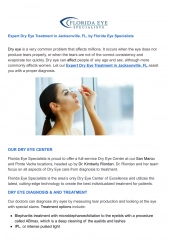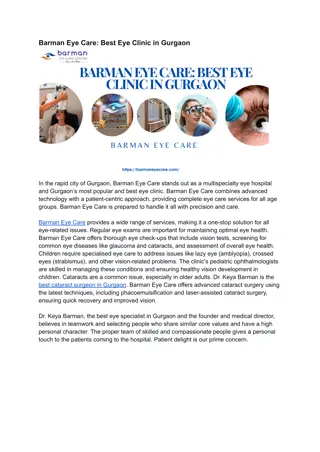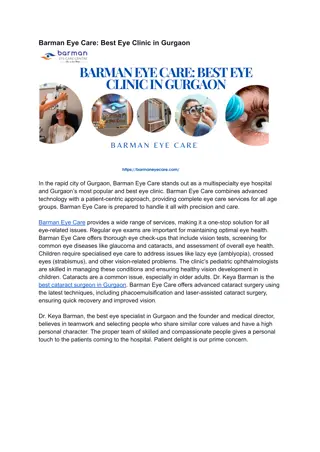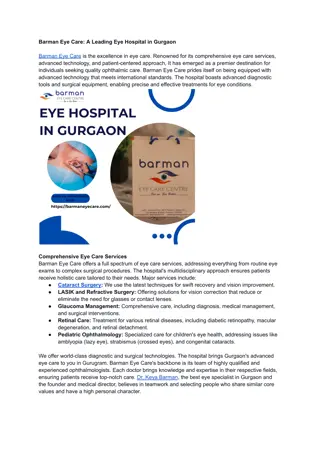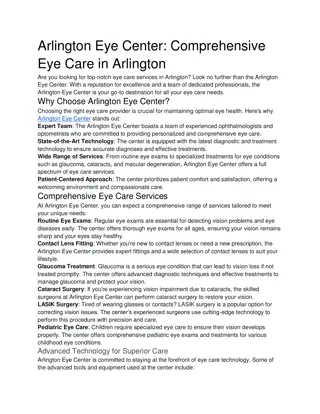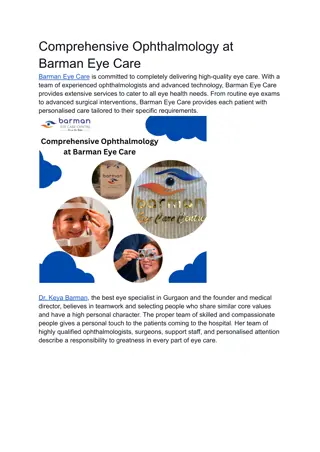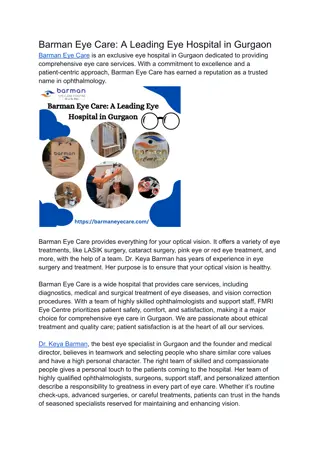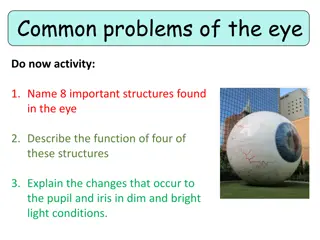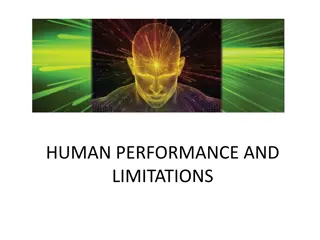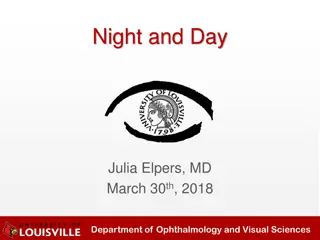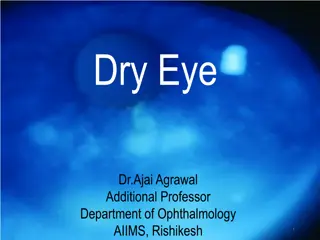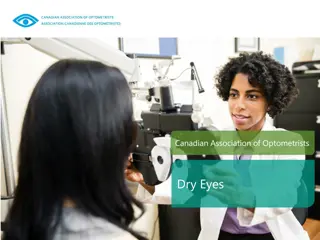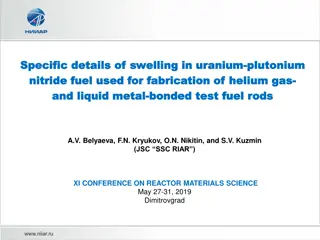Diagnosis and Management of Eye Swelling in Children
In this case-based scenario, an 8-year-old boy presents with left eye swelling, purulent nasal discharge, and low-grade fever. Explore the diagnosis of left orbital cellulitis with subperiosteal abscess or left ethmoidal sinusitis, along with key physical exam findings, common causative pathogens, and potential complications. Additionally, a case involving a 65-year-old diver experiencing amnesia post-scuba diving is mentioned.
Download Presentation

Please find below an Image/Link to download the presentation.
The content on the website is provided AS IS for your information and personal use only. It may not be sold, licensed, or shared on other websites without obtaining consent from the author.If you encounter any issues during the download, it is possible that the publisher has removed the file from their server.
You are allowed to download the files provided on this website for personal or commercial use, subject to the condition that they are used lawfully. All files are the property of their respective owners.
The content on the website is provided AS IS for your information and personal use only. It may not be sold, licensed, or shared on other websites without obtaining consent from the author.
E N D
Presentation Transcript
JCM OSCE TKOH 4 November 2020
Case 1 An 8 year old boy presents with left eye painful swelling for 1 day. His mother also noted mild purulent nasal discharge for 1 week and low grade fever since 3 days ago. There was no history of trauma.
Case 1 https://www.chegg.com/
Case 1 Q1 What is the diagnosis ?
Case 1 Q1 What is the diagnosis? Left orbital cellulitis with subperiosteal abscess Left ethmoidal sinusitis
Case 1 Q2 Name 2 physical exam findings you would look for in this patient
Case 1 Q2 Name 2 physical exam findings you would look for in this patient Proptosis Painful ophthalmoplegia Chemosis Diplopia Relative afferent pupillary defect Visual impairment
Case 1 Uptodate
Case 1 Q3 Name 2 common causative pathogens for this condition
Case 1 Q3 Name 2 common causative pathogens for this condition Streptococcus pyogenes Streptococcus pneumoniae staphylococcus aureus Hemophilus influenzae Anaerobes
Case 1 Q4 Suggest 2 potential complications for this child
Case 1 Q4 Suggest 2 potential complications for this child Orbital abscess Cavernous sinus thrombosis Optic neuritis visual loss Endophthalmitis Intracranial infection
Case 2 A 65 years old man with good past health went scuba diving in Sai Kung with friends today Diving profile according to friend 25m for 30 mins 30m for 45 mins 20m for 30 mins 20m for 30 mins Not sure if having rapid ascent He was noted to be amnesic for 40 minutes of the diving event. He denied chest pain / earache / joint pain / head injury. No other neurological abnormality on exam. Vitals were stable
Case 2 Q1 What is the most likely diagnosis?
Case 2 Q1 What is the most likely diagnosis? Type II Decompression sickness with neurologic involvement
Case 2 Reference: Practice of emergency medicine 2nd Edition
Case 2 Q2 Name 2 risk factors for the above diagnosis
Case 2 Risk factors for decompression sickness Patient factor Inexperienced driver, male Right-to-left shunt/patent foramen ovale Alcohol consumption/dehydration Diving profile Rapid and multiple ascent Prolonged and deep dive Immediate air travel after diving Others
Case 2 Q3 Your colleague suggests you contact PYNEH for a therapeutic procedure. What is it?
Case 2 Q3 Your colleague suggests you contact PYNEH for a therapeutic procedure. What is it? Hyperbaric oxygen therapy
Case 2 Q4 What are the mechanisms of this therapeutic procedure for the condition ?
Case 2 Q4 What are the mechanisms of this therapeutic procedure for the condition ? Reduction of gas bubble size, based upon Boyle s Law Nitrogen bubbles is inversely related to the pressure exerted upon it. At 3 ATM, bubble volume decreases by two thirds Oxygenation to hypoxic tissues by increasing dissolved O2 content of arterial blood Accelerating absorption of bubbles by increasing nitrogen gradient from bubble to plasma
Case 2 Q5 Suggest 4 other indications in which this therapeutic procedure may be useful
Case 2 Q5 Suggest 4 other indications in which this therapeutic procedure may be useful Radiation necrosis of soft tissue and bone Carbon monoxide poisoning Crush injury / traumatic ischemia Necrotizing soft tissue infection Sensorineural hearing loss Central retinal artery occlusion Severe anaemia Actinomycotic brain abscess Compromised skin grafts / flaps Non-healing wounds Refractory osteomyelitis
Case 3 A 62 years old man, who was known hepatitis B carrier, was referred by GP for progressive weight loss for 1 month. Exam revealed jaundice, hepatomegaly and distended abdomen with shifting dullness. Bedside USG noted a space occupying lesion in background of small cirrhotic liver. Ascites was noted. Private CT was done.
Case 3 Q1 Name the abnormality labeled with the arrow
Case 3 Q1 Name the abnormality labeled with the arrow Esophageal varices
Case 3 The patient developed fresh hematemesis at A&E. You suspect bleeding from the structure labeled in Q1. Q2 Name 1 pharmacological agent that could be used to reduce bleeding
Case 3 Q2 Name 1 pharmacological agent that could be used to reduce bleeding Terlipressin (vasopressin analog) Octreotide (somatostatin analog)
Case 3 Patient continued massive hematemesis and soon went into hypovolemic shock despite fluid resuscitation and blood products transfusion. Surgeon advised temporary stabilization with a device. Q3 What is the procedure?
Case 3 Patient continued massive hematemesis and soon went into hypovolemic shock despite fluid resuscitation and blood products transfusion. Surgeon advised temporary stabilization with a device. Q3 What is the procedure? Balloon tamponade
Case 3 Q4 Name 2 choices of the device
Case 3 Q4 Name 2 choices of the device Sengstaken-Blakemore tube (3 lumens) Minnesota tube (4 lumens) Linton-Nachlas tube (single lumen)
Case 3 Q5 Suggest a class of drug that prevents re-bleeding for this condition
Case 3 Q5 Suggest a class of drug that prevents re-bleeding for this condition Non-selective beta-blocker e.g. propranolol, nadolol, carvedilol
Case 4 A 30-year-old man was sent to A&E in the evening unconscious. His vital signs are as follows: GCS E2V2M5 BP 85/55 Pulse 105/min, SpO2 100% RA, temp 35 C, flushing Pupils 3 mm sluggish, normal tone and jerks, no clonus Found a brown bottle with clear liquid beside him
Case 4 Q1 What 2 clinical features suggest that the patient has used a vasodilator?
Case 4 Q1 What 2 clinical features suggest that the patient has used a vasodilator? Hypotension Tachycardia Flushing
Case 4 Q2 His male partner says he inhaled the contents of the bottle. Name 1 reason for the patient to use the substance.
Case 4 Q2 His male partner says he inhaled the contents of the bottle. Name 1 reason for the patient to use the substance. Relaxation of throat and anal involuntary smooth muscles through vasodilatation (popularized to facilitate anal [and sometimes vaginal] sex in penetration) For euphoria/ rush as recreational drug
Case 4 Q3 Name 2 possible substances that the brown bottle may contain.
Case 4 Q3 Name 2 possible substances that the brown bottle may contain. Alkyl nitrites ( Poppers ) Gamma hydroxybutyrate (GHB)
Case 4 Q4 If the patient develops cyanosis, name one investigation you are going to do.
Case 4 Q4 If the patient develops cyanosis, name one investigation you are going to do. Methaemoglobin level
Case 4 Q5 How would you manage this patient?
Case 4 Q5 How would you manage this patient? Close monitoring of airway patency, ventilation and conscious level IV crystalloid for hypotension N.B. Beware of concomitant phosphodiesterase inhibitor use profound hypotenison Naloxone if severe GHB-associated respiratory/CNS depression is suspected Urine toxicology +/- bottle contents for toxicology
Case 4 Poppers Popper is a slang term given broadly to drugs of the chemical class called alkyl nitrites that are inhaled. Includes amyl nitrite, isobutyl nitrite, isopentyl nitrite, isopropyl nitrite etc. Packaged as leather cleaner, room deordorizers etc. (in the US/UK) Alkyl nitrites have very low vapor points Called poppers in the 1970s as they were packaged in glassed ampoules wrapped in cloth, to be popped with fingers to inhale the contents Illegal in Canada, EU as drugs
Case 4 - Poppers Uses and effects Reduction to nitric oxide --> relaxion of throat and anal involuntary smooth muscles through vasodilatation Popularized to facilitate anal (and sometimes vaginal) sex in penetration Recreational use: for the high or rush Effects: vasodilatation --> flushing, headache, palpitations Disinhibition, euphoria
Case 4 Poppers Toxicity Vasodilatation: Tachycardia ,Sudden hypotension Methemoglobinemia if oral ingestion (can be fatal) Inhalation use rarely overdosed as vaporized rapidly Interaction with sildenafil, tadalafil, TNG etc. [also vasodilators] fatal hypotension Maculopathy with isopropyl nitrite


